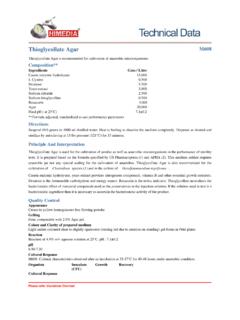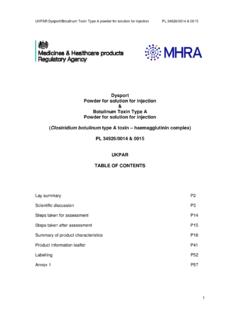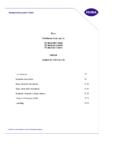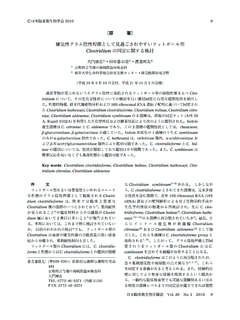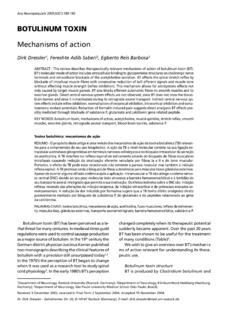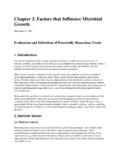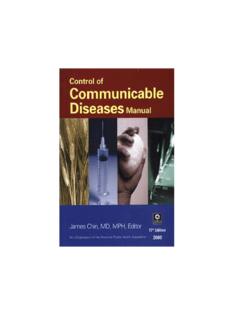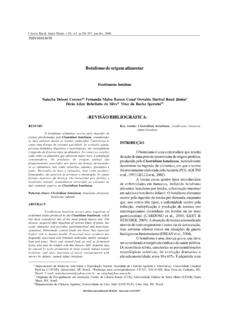Transcription of CLOSTRIDIUM BOTULINUM - WHO
1 CLOSTRIDIUM . BOTULINUM . International Programme on Chemical Safety Poisons Information Monograph 858. Bacteria world health organization . International Programme on Chemical Safety Poisons Information Monograph 858. TABLE OF CONTENTS. 1. 5. Scientific 5. 5. Common names and 5. 2. 5. Main risks and target 5. Summary of clinical 5. 6. First Aid Measures and Management 7. Poisonous parts .. 7. Main 8. 3. 8. Description of the 8. Special identification 8. 8. 8. Poisonous parts .. 9. The 9. Name(s).. 9. Description, chemical structure, 9. Other physicochemical 10. Other Chemical Contents of the 10. 4 USES/CIRCUMSTANCES OF 10. 10. Uses .. 10. 10. High risk circumstances .. 10. High risk geographical 12. 5. ROUTES OF 12. Oral .. 12. Inhalation .. 13. 13. 13. Parenteral .. 13. 13. 6. 14. Absorption by route of 14. Distribution by routes of 14.
2 Biological half-life by routes of 14. 14. Elimination and 14. 7. 15. Mode of 15. 15. Human 15. Relevant animal 16. Relevant in vitro 16. Bacteria _____Clostridium BOTULINUM 2. International Programme on Chemical Safety Poisons Information Monograph 858. 17. 17. 17. 17. 8. TOXICOLOGICAL ANALYSES AND BIOMEDICAL 17. Material sampling 17. Sampling and specimen 17. Storage of laboratory samples and 18. Transport of laboratory samples and 18. Biomedical investigations and their 19. Biochemical 19. Other biomedical (diagnostic) investigations and their 19. 9. CLINICAL 19. Acute 19. 19. 20. Skin 20. Eye 20. Parenteral 20. Chronic 20. 20. 20. Skin 20. Eye 20. Parenteral 21. Course, prognosis, cause of death .. 21. Foodborne 21. Systematic description of clinical 21. 21. 21. 21. 22. Hepatic .. 22. 22. Endocrine and reproductive 22.
3 22. Eye, ear, nose, throat: local 23. 23. Immunological .. 23. 23. Allergic 23. Other clinical 23. Special risks .. 23. 24. 10. 24. General principles .. 24. Life supportive procedures and symptomatic/specific 24. Decontamination .. 24. Enhanced 25. Antidote/antitoxin 25. Bacteria _____Clostridium BOTULINUM 3. International Programme on Chemical Safety Poisons Information Monograph 858. 11. ILLUSTRATIVE 27. Case reports from 27. 12. ADDITIONAL 28. Specific preventive 28. 13. 29. 14. AUTHOR(S), REVIEWER(S) DATA (INCLUDING EACH UPDATING), COMPLETE 32. Bacteria _____Clostridium BOTULINUM 4. International Programme on Chemical Safety Poisons Information Monograph 858. 1. NAME. Scientific name CLOSTRIDIUM BOTULINUM Family CLOSTRIDIUM Endospore-forming gram-positive bacilli Common names and synonyms BOTULINUM toxin.
4 Toxinum BOTULINUM ;. BOTULINUM A toxin haemagglutinin complex;. Oculinum (Allergan Pharmaceuticals, USA);. Botox (produced by Allergan Pharmaceuticals, USA);. Dysport (produced by Ipsen, UK);. -DG NLH EDVLDQ\ 3 ROLVK . 2. SUMMARY. Main risks and target organs Botulism is characterised by symmetrical, descending, flaccid paralysis of motor and autonomic nerves usually beginning with cranial nerves. It occurs when neuromuscular transmission is inter- rupted by a protein neurotoxin produced by the spore-forming, obligate anaerobic bacterium Clos- tridium BOTULINUM . Paralysis begins with the cranial nerves, then affects the upper extremities, the respiratory muscles, and, finally, the lower extremities in a proximal-to-distal pattern. In severe cases, extensive respiratory muscle paralysis leads to ventilatory failure and death unless suppor- tive care is provided.
5 Summary of clinical effects There are five clinical categories of botulism: 1) foodborne botulism; 2) wound botulism; 3) infant botulism; 4) adult infectious botulism; 5) inadvertent, following BOTULINUM toxin injection. Foodborne botulism Onset generally occurs 18 to 36 hours after exposure (range, 6 hours to 8 days). Initial symptoms can include nausea, vomiting, abdominal cramps or diarrhoea. After the onset of neurologic symptoms, constipation is typical. Dry mouth, blurred vision, and diplopia are usually the earliest neurologic symptoms. They are followed by dysphonia, dysarthria, dysphagia, and peripheral muscle weakness. Symmetric descending paralysis is characteristic of botulism. Wound botulism This can be defined as clinical evidence of botulism following lesions, with a resultant infected wound and no history suggestive of foodborne illness.
6 Except for the gastrointestinal symptoms, the clinical manifestations are similar to those seen in foodborne botulism. However, the incubation period is much longer as time is required for the incubation of spores, growth of CLOSTRIDIUM and release of toxins (4 to 14 days). Bacteria _____Clostridium BOTULINUM 5. International Programme on Chemical Safety Poisons Information Monograph 858. Infant botulism This is caused by the absorption of toxin produced by CLOSTRIDIUM BOTULINUM that colonize the intestinal tracts of infants under one year of age. It is often associated with ingestion of honey and the first clinical sign is usually constipation. After a few weeks, progressive weakness and poor feeding are observed. The weakness is symmetrical and descending. It evolves over hours or several days. The infant is afebrile and has a weak cry, has either absent or diminished spontaneous movements, decreased sucking, floppy head and decreased motor response to stimuli.
7 The autonomic nervous system manifestations include dry mucous membranes, urinary retention, diminished gastro-intestinal motility, fluctuation of heart rate, and changes in skin colour. Duration of hospitalisation may last from a few days to six months. Adult infectious botulism It occurs as a result of intestinal colonization with C. BOTULINUM and in vivo toxin production in a manner similar to that of infant botulism. These patients often have a history of abdominal surgery, achlorhydria, Crohn's disease or recent antibiotic treatment. The disease may simulate a Guillain- Barr Syndrome. Inadvertent botulism This has been reported in patients who have been treated with intramuscular injections of BOTULINUM toxin. Marked clinical weakness is observed as well as electrophysiologic abnormalities. Diagnosis Foodborne botulism This should be suspected in a patient with acute onset of gastro-intestinal symptoms associated with autonomic (dry mouth, difficulty focusing eyes) and cranial nerves dysfunction (ptosis, diplopia, dysarthria, dysphagia).
8 A history of home-prepared or home-preserved food (often, inadequately pasteurized vegetables) and similar symptoms in people who have shared the same food increases likelihood of the diagnosis. The initial diagnosis should be made on the basis of history and physical findings. Confirmatory tests may take days to be performed. Serum, stools and suspected food should be tested for the presence of botulism. The mouse inoculation test is still the most reliable method. Stool specimens should be cultured for C. BOTULINUM as a confirmatory test. Isolation of C. BOTULINUM organism devoid of toxin from the suspected food has little significance. Wound botulism Specimens of wound exudate, a tissue sample, or a swab sample should be obtained for anaerobic culture in addition to a serum toxin assay. A stool specimen should be obtained in order to exclude food or intestinal colonization as sources of toxin.
9 Infant botulism This should be suspected in an infant with constipation, poor feeding, diminished sucking and crying ability, neck and peripheral muscle weakness, or ventilatory distress. Stool cultures for C. BOTULINUM and testing for the presence of toxin in the stool should be performed in such patients. Adult infectious botulism This is a rare disease and should be suspected in patients with some abnormality of the gastro- intestinal tract who develop cranial nerve autonomic dysfunction, and muscular weakness. Stool cultures for C. BOTULINUM and testing for the presence of toxin should be performed. Endogenous antibody production to BOTULINUM toxin has been described. Inadvertent botulism This may be suspected in patients with recent history of botulin A toxin injection, especially into big muscles for systemic effect, or perhaps, in a suicide attempt.
10 Bacteria _____Clostridium BOTULINUM 6. International Programme on Chemical Safety Poisons Information Monograph 858. First Aid Measures and Management Principles Foodborne botulism Emptying the stomach by gastric lavage or induction of vomiting with syrup of ipecac could be con- sidered if the suspected food ingestion was recent (within 1 hour). It should not be attempted if neu- rological symptoms are already present. Administer activated charcoal and a cathartic (such as sorbitol) but not magnesium salts since magnesium may potentiate neuromuscular block. Maintain airway and assist ventilation if required. Obtain arterial blood gases. Monitor respiration closely since respiratory arrest can occur abruptly. Administer Trivalent ABE antitoxin (7500 IU of type A, 5500 IU of type B, and 8500 IU of type E. antitoxins) per patient.










